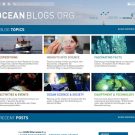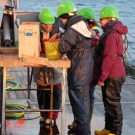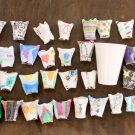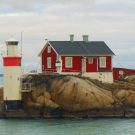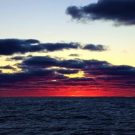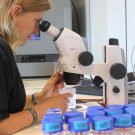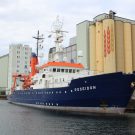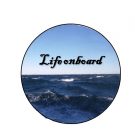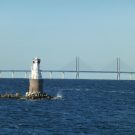Redesign oceanblogs.org & Containerumzug Future Ocean Die letzte Woche hat im Wesentlichen zwei Veränderungen mit sich gebracht: Zum einen erstrahlt unser Blog ab heute nachmittag in einem neuen Design. Für eine bessere Übersicht über die Themengebiete sorgen die neuen Blog Topics. Topics wie Expeditions, Activities & Events und Ocean Science & Society bieten einen schnellen […]
Sampling techniques at sea
Doing science at sea is more difficult as on land because it is not easily accessible. Therefore we needed some special devices to get an insight into the marine fauna. To measure different properties of the water body we used the CTD as he first device at every station. CTD stands for conductivity (salinity), […]
Kunst aus fast 4000 Metern Tiefe
Ein bisschen Spaß muss sein – also haben wir uns alle mit Begeisterung auf die von Nina mitgebrachten Styroporbecher gestürzt. Mit Wachsmalstiften und Edding waren der Kreativität keine Grenzen gesetzt und sehr ausgefallene Exemplare entstanden. In einem Netz gesammelt, wurden die Becher dann mit dem nächsten Großkastengreifer in eine Tiefe von 3862 m herabgelassen. Wieder […]
Cruising to Kristineberg
After sampling for 2 days in the Skagerrak, we arrived on a sunny day in the city of Gothenberg through a fjord dotted with rocky outcrops and picturesque lighthouses. Gothenberg is the second biggest city in Sweden, home of Göteberg University and an eclectic mix of historical and modern buildings. Although our first evening was […]
Quallenzeit
Der Sommer ist nun endgültig vorbei und damit findet auch die Zeit der Quallen langsam ein Ende. Die wohl bekannteste Qualle, die Ohrenqualle mit dem wohlklingenden Namen Aurelia aurita hat ihren Zenit längst überschritten und ist jetzt nur noch selten zu sehen. Dieses Jahr hat sie keine übergroße Aufmerksamkeit erregt. Jedes Jahr zur Quallenblüte bekommen wir […]
The Graveyard Shift
The problem with such strict and frequent sampling schedules on research vessels is that night shifts are inevitable; the time and financial restraints of such a cruise mean that you cannot afford to wait around at a station until the sun is up, the weather is favourable, and more importantly, the personnel are awake! The […]
Fütterung der “Forams” – eine langwierige Aufgabe
Mittlerweile wurden mit dem Handnetz genügend Foraminiferen (Kammerlinge) gefangen, um sie an Bord für Experimente zu halten. Die Idee ist, zu sehen, ob die Foraminiferen auf ein zusätzliches künstliches Magnetfeld reagieren. Es gibt eine Kontrollgruppe ohne zusätzliches Magnetfeld und die Experimentalgruppe mit einem Magneten. Dafür kommt je eine Foraminifere in eine 50 ml-Flasche mit filtriertem […]
What’s special about RV Poseidon?
Now that Leila and Julia have already described life on board of the research vessel Poseidon, it’s time to talk about the ship itself. With its 40 years of travelling the seas, Poseidon is the Old Lady of the German research fleet. It is 60.8 m long, 11.4 m wide and has a draught of […]
Life onboard
Welcome to our new home, on board Poseidon. We are 8 students on a research cruise for our Master program in Biological Oceanography at the GEOMAR. It has been 10 days now and we are amazed by how much we have learnt and achieved in such a short time. Despite the tight sampling schedule and […]
Sea dogs on shore leave
After two days and the first 15 sampling stations we arrived in Malmö, Sweden on Sunday, October 2nd at 9 o’clock in the morning. With around 312.000 inhabitants, Malmö is the third largest city of Sweden. On our way to Malmö we passed under the Øresundbridge, which is the world longest combined railway and motorway […]
